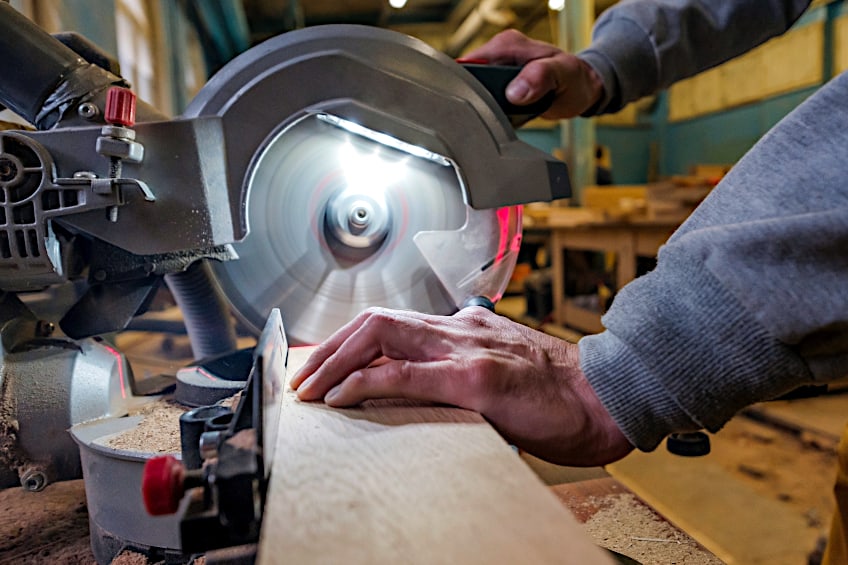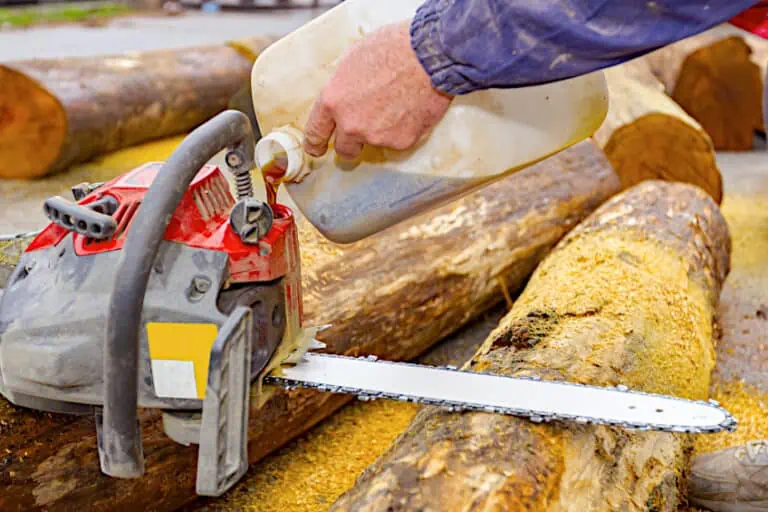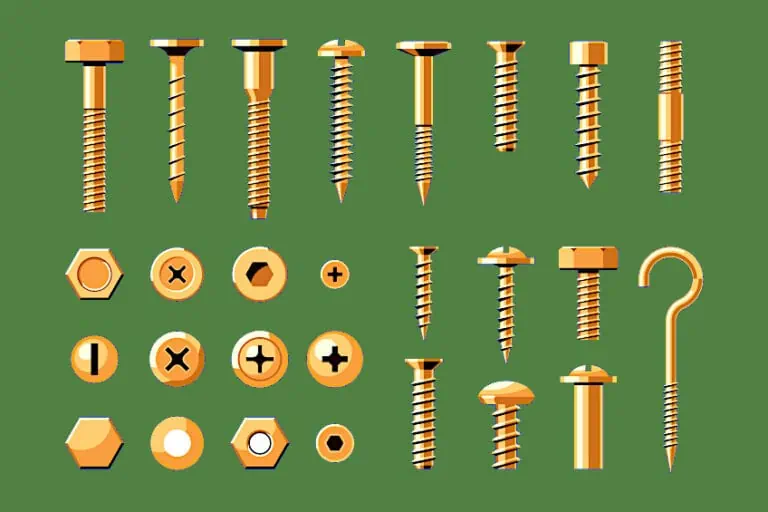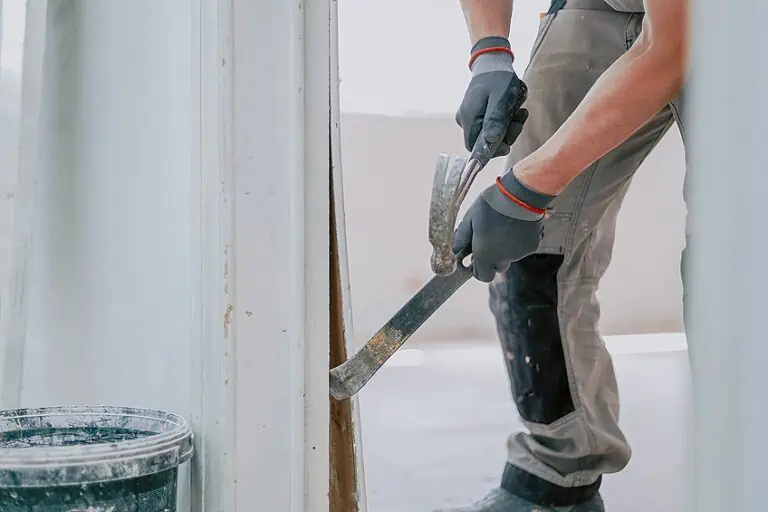Chop Saw vs. Miter Saw – Similar Looks, Different Uses
If you’re an experienced woodworker, then you’ve probably used both a chop saw and a miter saw before. Could you tell the difference between them if you needed to, though? Miter saws and chop saws look similar and are often used for the same applications, but there are a few distinctions between them that make each tool unique. With that being said, let’s have a look at some of the key differences and the applications of these two saw types, as well as how to tell the difference between them if you’re ever unsure.
Table of Contents
Chop Saw vs. Miter Saw: What Is the Difference?
As the name would suggest, the chop saw’s primary action is to chop downward, much in the same way you would use an axe or machete. Chop saws are essentially circular motorized blades that have been attached to the end of an arm. The arm is capable of pivoting up and down at a 90-degree angle, cutting your workpiece when brought all the way down.
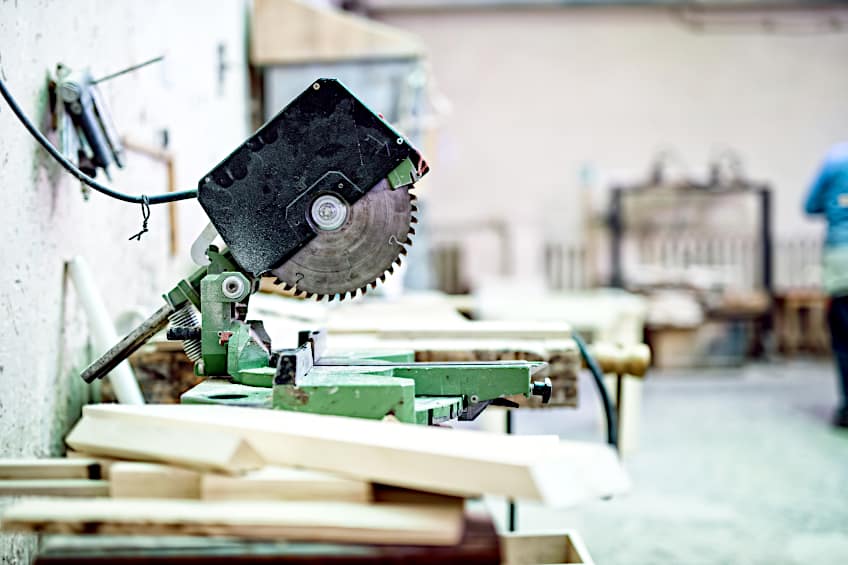
The circular blade is motorized, rotating as the arm is brought down. Officially, the intended purpose of the chop saw is to create cross-cuts. It can be challenging to do much else with it, but since the device’s fence can be moved at a 45-degree angle it is possible to cut miters with a chop saw as well. Is this recommended? Only if you can do so safely and if you have sufficient experience with this blade.
What is a miter saw then? Miter saws are far more versatile and can easily be used to create a number of different cuts simply by adjusting the angle and reach of the blade. The miter saw’s range of motion is far larger than that of the chop saw, but they’re often confused with one another due to both of their primary operations being a straight up and down motion.
Unlike chop saws, miter saws can be rotated, pushed back or pulled forward, moved from left to right, or offset at 45 degrees. This makes them far more versatile compared to chop saws, but they are a lot more expensive. This makes them less accessible to DIY woodworking enthusiasts, which is why they’re generally found in professional or commercial environments.
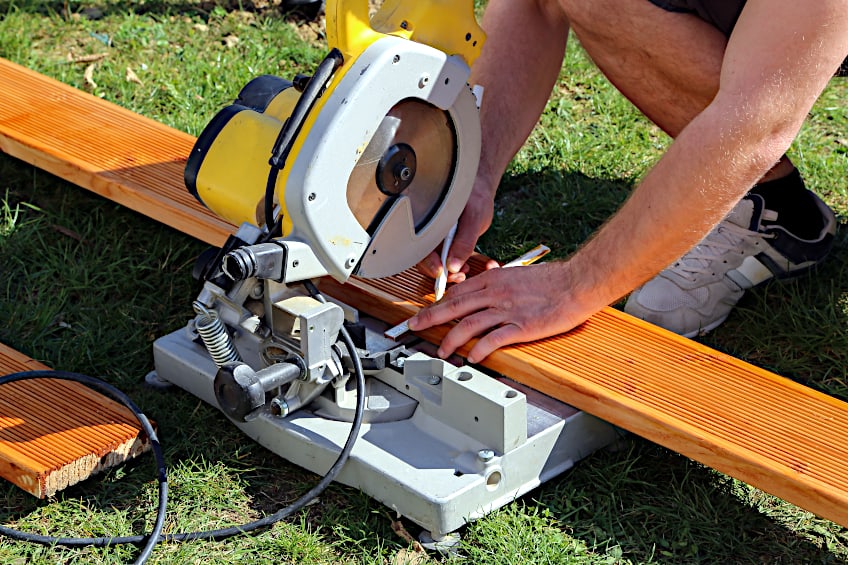
What Is the Difference Between Chop Saw and Miter Saw Applications?
Miter saws and chop saws appear similar, but have different functions. If you already have a miter saw, you could use it to do the same cuts as a chop saw, but going out and buying a miter saw if you only need the functionality of a chop saw would be expensive overkill. Also if you need to do multiple 90-degree cuts over a short period of time, you may find that your miter saw is a bit underpowered for the challenge. Does that mean that miter saws are superior to chop saws? Not necessarily. Saying that one is better than the other doesn’t really mean anything considering the difference in price, applications, and the fact that both tools have units of varying intricacy and functionality available for purchase.
The key difference between a chop saw and miter saw units is their range of motion and versatility. While the chops saw is simply a blade that moves up and down at a 90-degree angle on an arm, the miter saw possesses a far greater range of motion that allows you to extend the blade’s reach and adjust its angle of approach.
This doesn’t mean that one is better than the other, it simply means that they’re designed to meet different needs. If you have your own woodworking business and need to cut a large number of boards on a daily basis, the chop saw is perfect. By contrast, if you’re doing a wide variety of cuts, joinery, and/or alterations on a daily basis, the miter saw would be far better suited to your needs.
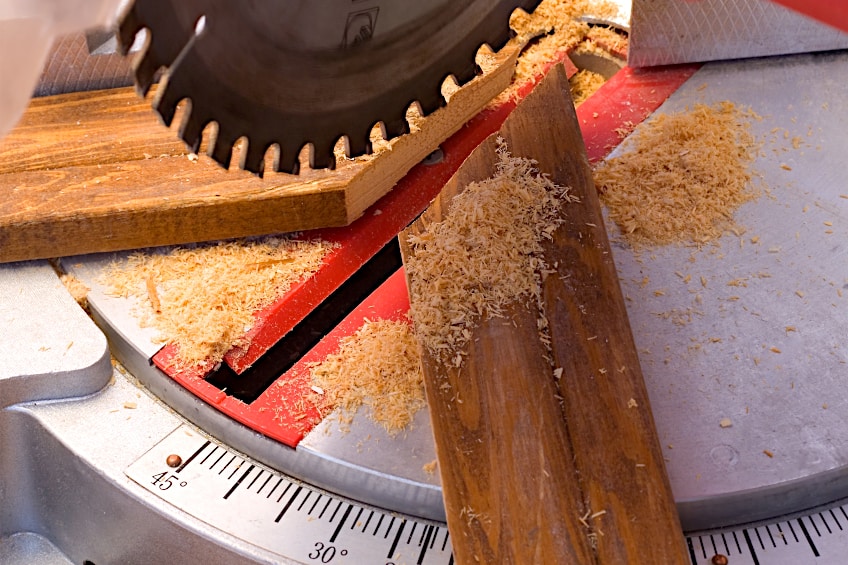
That being said, chop saws are rarely used for wood cutting these days. Instead, due to certain chop saw blades being able to cut through steel, they are often used in mechanical engineering and/or fabricating environments. This doesn’t mean that they can’t be used for woodworking, they’re just simple, effective, and reliable enough to be used for both applications.
Chop Saw Overview
The accepted definition of a chops saw is a saw that has been designed for creating cross-cuts on lumber. Whether this is cutting the length or width of the board the chop saw can do it all, using its motorized circular saw attached to an arm that can be lowered and raised to cleanly cut through pretty much any wooden or metal workpiece.
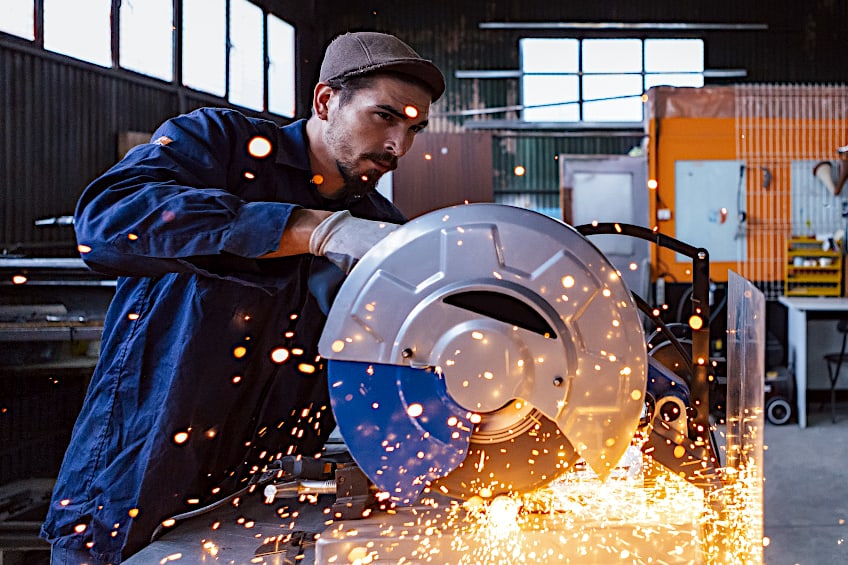
Unfortunately, its angle of approach cannot be adjusted which means the chop saw is only capable of cutting at a 90-degree downward angle. The chop saw is more than just the motorized blade though, it comes with a table, fence, and come clamps that allow you to support and secure your workpiece as you cut.
Chop saws are pretty easy to use too. To operate your chop saw all that you need to do is secure your workpiece using the clamps provided and position it against the fence. Once positioned and secure, check the guards on your circular blade and activate it. Next, grab the handle and slowly bring the blade down to create your cut. Once you’re through, raise the blade once more if it does not do so automatically.
As you can see, chops saws are easy to use and pretty useful if you have a lot of simple cuts to do. Automated versions are typically used in mass production environments which are usually computer numerically controlled (CNC). These are set to cut at certain depths for a certain amount of workpieces, and can cut hundreds of workpieces an hour!
Chop Saw Advantages
Chop saws are great tools, and while they might be simple tools that are often taken for granted, woodworking would be far more difficult without them. Chop saws have extremely powerful and rather durable motors that allow them to spin at thousands of revolutions per minute while in operation, giving you unparalleled cutting ability. They are also capable of cutting through a wide range of materials thanks to the combination of their powerful motors and the range of cutting blades available for them. Chop saws are capable of cutting through wood, metal, plastic, and even certain types of rubber if you have the right blade for the job. This is partially why they are so widely used.
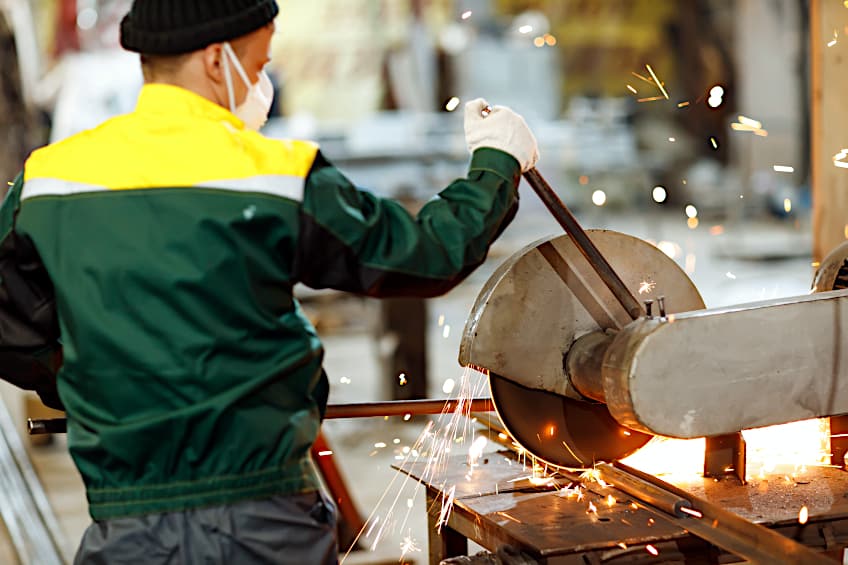
Another notable advantage of the chop saw is its simplicity. While other cutting tools require you to adjust the cutting angle, depth, range, table, and clamps, the chop saw only requires you to secure your workpiece and adjust the depth of your cut. This simplicity not only makes the chop saw easier to use, but also makes it more affordable when compared to miter saws.
Finally, chop saws work quickly. Once your workpiece has been secured all that you need to do is turn the motor on and plunge your cutting blade into the workpiece. Modern chop saws have the arm and blade return to the resting position automatically, making for quick and easy operation compared to other cutting implements.
Chop Saw Disadvantages
While there are many advantages to using a chop saw there are also many disadvantages. These mostly revolve around the limitations you’re presented with compared to using a miter saw, but considering the price and size difference between the two this is to be expected. That being said, let’s have a look at some of the downsides of using a chop saw. For one, a chop saw is pretty loud compared to other cutting machinery. This makes sense considering that chops saws are equipped with powerful motors that allow them to achieve thousands of rotations per minute. This combined with the noise of actually cutting through your material means that it’s best to wear earplugs when operating one.
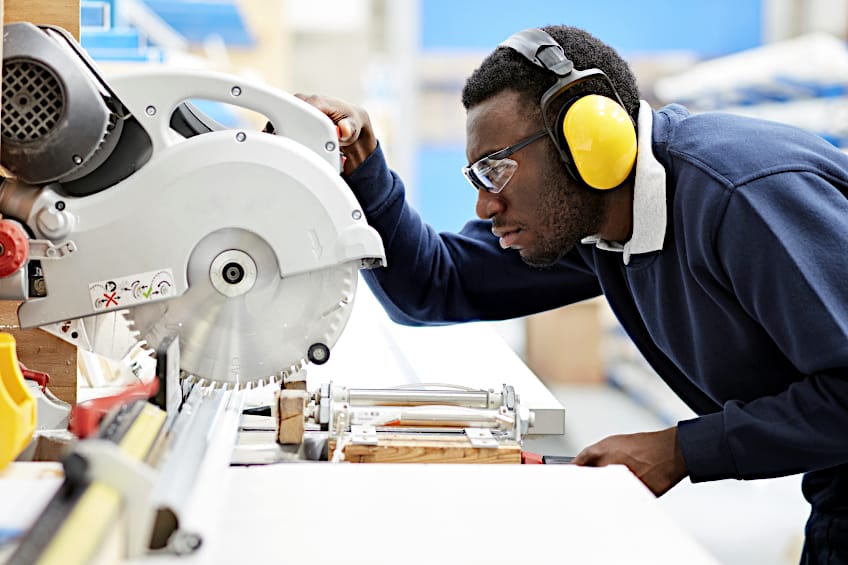
Chop saws are also quite popular when cutting metal tubing. However, they tend to throw around a lot of sparks while in operation. This makes sense considering the velocity of the blade once it makes contact with metal, but the number of sparks produced when with the guard on can be excessive to some, so it’s best to consider this if you’re thinking about using your saw for metal cutting.
The most glaring drawback of the chop saw is the fact that it does not allow you to cut wood or any other material at an angle other than 90 degrees. This can be frustrating and cumbersome, especially since miter saws are capable of cutting at many angles. However, considering the difference in price and size between the two, it does make sense.
Finally, you should consider that chop saws are a bit more dangerous to use compared to miter saws. This isn’t due to a lack of guards or failsafe mechanisms, but simply because chop saws make use of extremely powerful motors. During operation, one could easily rip material (wood, metal, or plastic) instead of cutting through it and throwing debris everywhere.
Miter Saw Overview
Mite saws are incredibly versatile machines that are capable of cutting at a wide variety of angles, allowing you to cut joints, tapers, recesses, and many other incisions. Miter saws are also available in two types, namely the simple miter saw, and the compound miter saw that is able to be extended via the use of telescopic arms.
Miter saws are generally larger and heavier than chop saws due to all of the extra components incorporated into them. This allows them to create a number of cuts, and allows the head of the blade to be offset at a 45-degree angle. This is extremely useful as you can simply rotate the blade instead of having to re-orientate your entire workpiece.
The table of the miter saw is also notably different compared to a chop saw. The front of the table is round while the chop saw’s table is squared. The table of the miter saw is also marked with an angle gauge which allows you to dial in the cutting angle of your blade using a lever near the front of the table. This position can be locked in, so the angles do not change during operation.
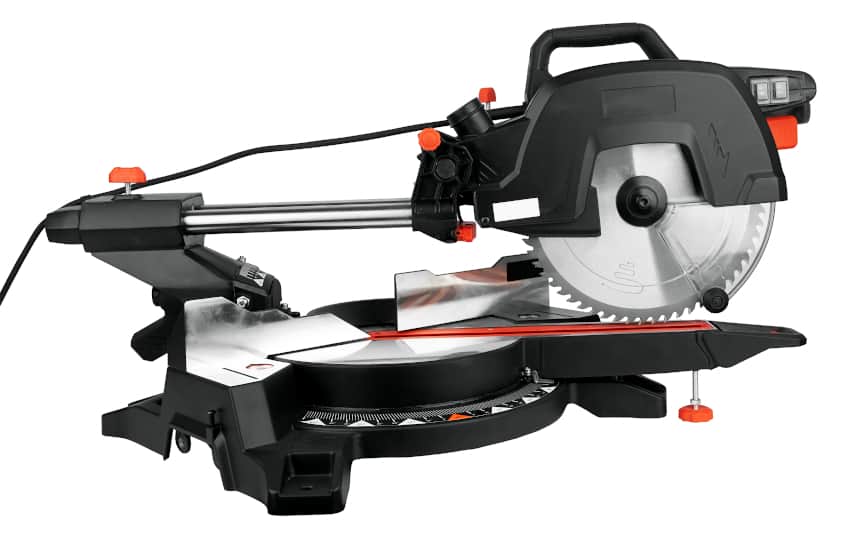
Compound miter saws take things a bit further, allowing you not only to adjust the blade’s angle of approach or move it back and forth but also allows you to move the blade on a horizontal axis along the length of your table. Pretty cool right? Miter saws are incredibly versatile and are capable of cutting through many types of materials, much like chop saws.
Miter Saw Advantages
Miter saws have many glaring advantages, especially when compared to chop saws. For one, some miter saw blades can be moved back and forth (toward or away from you) which allows you to cut wider workpieces with ease. If this was not the case you would have to unclamp your workpiece and move it to complete the cut, which is time-consuming.
The most obvious advantage of the miter saw is that the angle of approach of the cutting blade can be adjusted. This allows you to create a number of cuts that would otherwise require the use of a handsaw, or for you to adjust your workpiece. These angles can be dialed in using the angle gauge present on the surface of a miter saws table.
Miter saws are also capable of moving along a Y-axis. While this functionality is limited to compound miter saws, it is becoming more commonplace in entry-level tools and will likely become standard in the future. This allows you to make multiple cuts along the length of the same workpiece, and/or differently angled cuts along the length of the same workpiece.
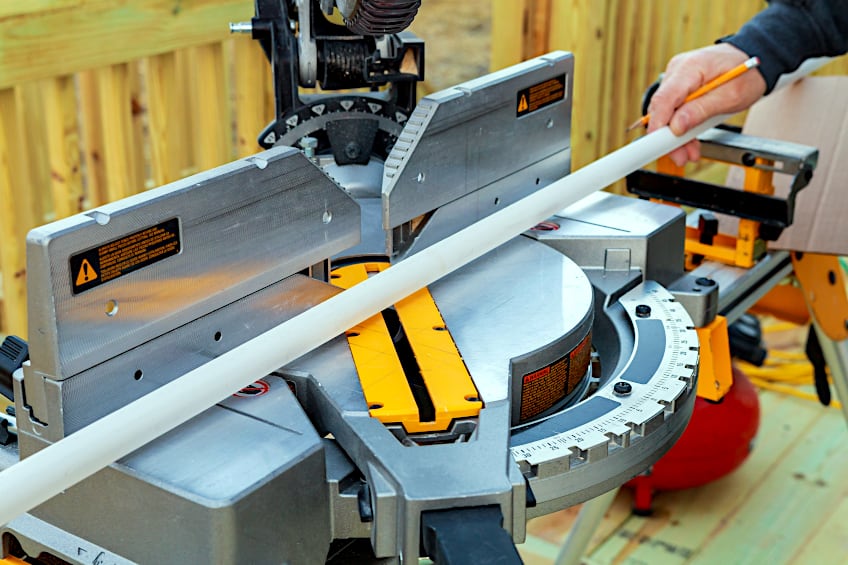
The primary advantage that nicely sums up all of the aforementioned characteristics is the versatility of the miter saw. The miter saw allows you to cut at virtually any angle, with a workpiece of virtually any size, without having to adjust the workpiece, unless you intend to cut underneath it. These characteristics can save you a lot of time and effort, especially in a production environment.
Miter Saw Disadvantages
With a tool this versatile you would be hard-pressed to find anything wrong with it, but there are some notable drawbacks to using the miter saw. For one, the miter saw is far more expensive compared to the chop saw, and unless you intend to use all of its features you’re likely better off going with the chop saw. It’s also a lot heavier than a chop saw since there are more moving parts and joints. This could be a deal breaker if you constantly need to move your machinery around, but there isn’t too much of a difference if this is a major concern. That being said, space comes at a premium for most of us these days, and miter saws can take up a nice chunk of your workspace.
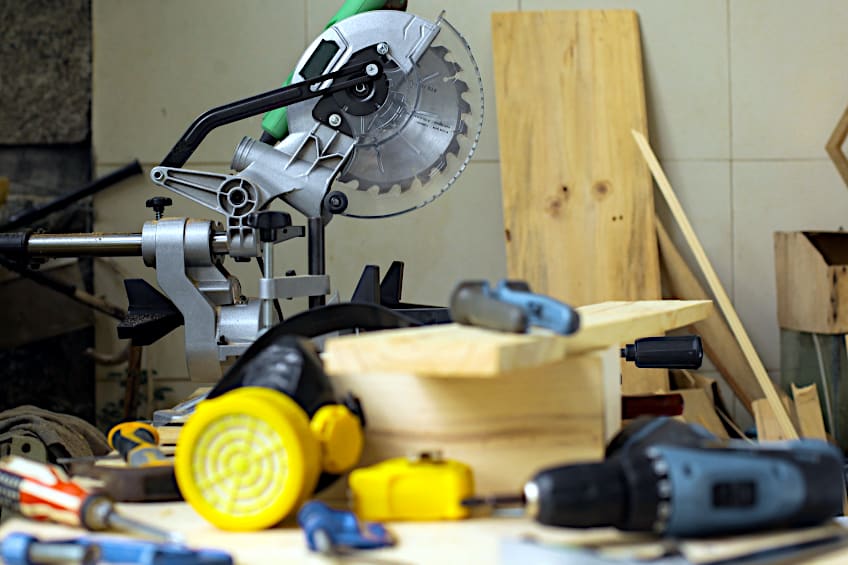
One thing you should consider is that the miter saw is considerably more expensive to repair compared to the relatively simple chop saw. After all, there are more moving parts, which typically need to be specially ordered in the event that something breaks. This means waiting a while and forking out more cash should something break.
A disadvantage that the miter saw shares with the chop saw is that it is quite powerful, and can cause debris to fly all over your workspace if used incorrectly. Despite the various guards and other safety features on the miter saw it is a powerful machine, and no matter how careful you are, accidents inevitably happen. That being said, it’s best to be extra careful when working with these saws.
Chop Saw vs. Miter Saw Comparison
Now that you know what each machine does and what some of the key advantages and disadvantages to them are, we thought we’d compare some of the other important points associated with each of them. Remember that these can both be quite pricey and that owning one will essentially be an investment that will (hopefully) pay for itself over the years.
Price Range
For the sake of simplicity, we’ll be having a look at full-size saw units for this comparison. The average price of a full-sized miter saw including the bench and table can be a couple of thousand dollars. These are incredibly capable and often are equipped with even more features than a standard compound miter saw.
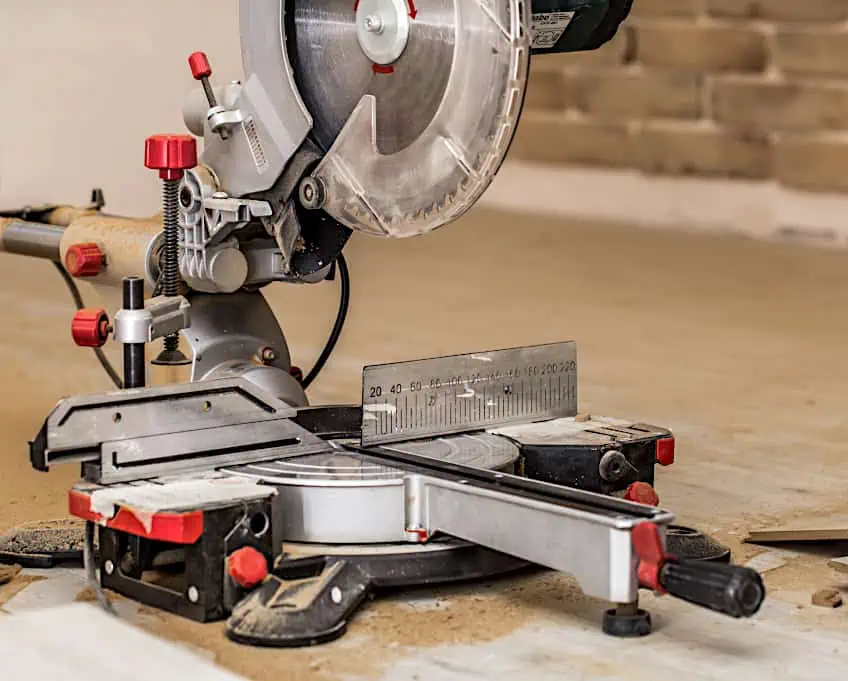
In comparison, a full-sized chop saw can cost significantly less than a miter saw. These are pretty straightforward machines with very few bells and whistles compared to miter saw units, but even at full size most of them tend to be collapsible. This is because contractors often take these from job site to job site, and a table can be purchased separately as well.
If you’ve done some shopping around then you’ve probably found that the portable versions of the miter saw and chop saw are far less expensive compared to the full-sized versions. There isn’t too much of a difference between the price of portable units, but due to the miter saw being more versatile and costing more to make, the chop saw is still noticeably cheaper.
Miter saws are nearly $900,00. They generally feature an incredible range of motion and modern ones like these are completely cordless, only needing to be charged every once in a while. Compared to this simple chop saw from Evolution Power Tools that cost about $190,00, you definitely get what you pay for.
Cutting Capacity and Blade Size
Cutting capacity of the miter saw and the chop saw, size definitely matters. The diameter of the blade will essentially determine how deep the saw will be able to cut, so the bigger the blade the deeper the blade will be able to plunge. Generally speaking though, both miter saws and chop saws bottom out at about 12 inches of penetration at a 90-degree angle.
That being said, which one has the bigger blades? Generally speaking, chopping saws have far larger blades straight out of the box when compared to miter saws, giving them a larger cutting capacity between the two. Miter saws also aren’t always as powerful as chop saws, instead sacrificing their power for versatility and multiple cutting angles.
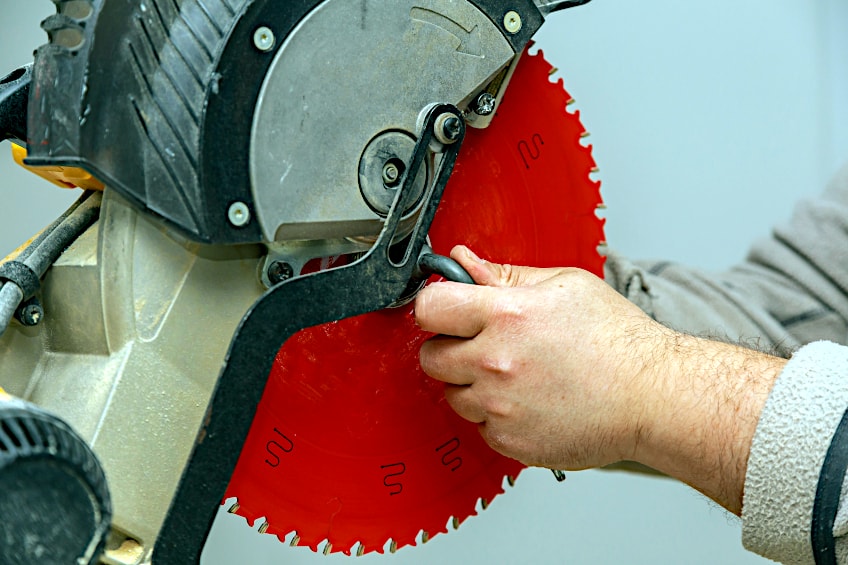
Accuracy and Precision
Most people think that accuracy and precision are one in the same when in reality they are two different measurements. Put simply, accuracy is true to intention, whereas precision is true to itself. This begs the question, which is the most precise between the chop saw and the miter saw? Well, you usually get what you pay for.
While the chop saw might have the cutting capacity advantage of the miter saw, the miter saw is far more accurate and precise. The miter saw’s cutting depth and angle of approach can be adjusted to the extreme degrees of accuracy and can be locked in for repetitive use. There isn’t much competition between the two in this regard.
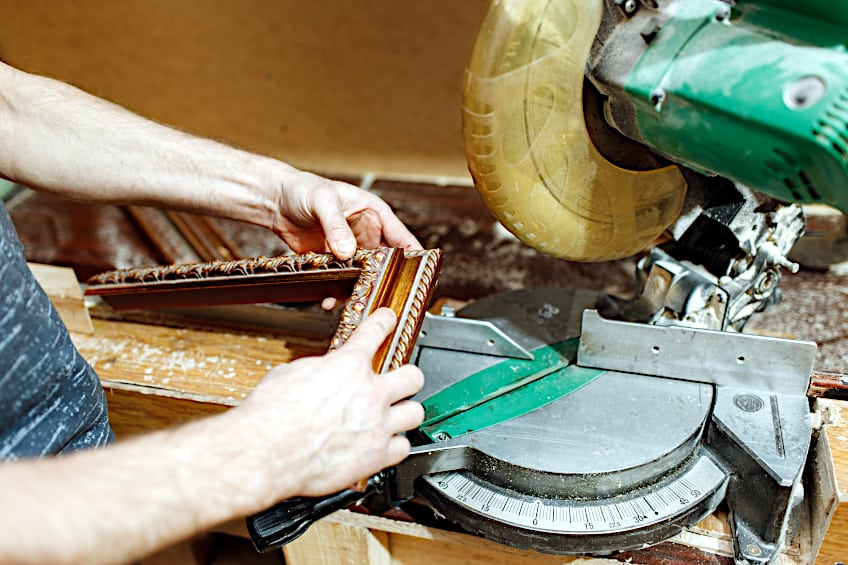
Safety Features
Safety features are super important when working with any type of power tool and are no less important when it comes to chopping and miter blades. Both of these saws have essential safety features such as emergency stops, surge protection, and of course guards that cover the edges of the blades.
Newly produced units are generally as safe as these saws can be, but since the miter saw has a greater range of motion it will sometimes have additional and/or adjustable guards and safety precautions than a chop saw. Despite these features, it is always advisable to wear the correct safety gear when using electric saws of any type.
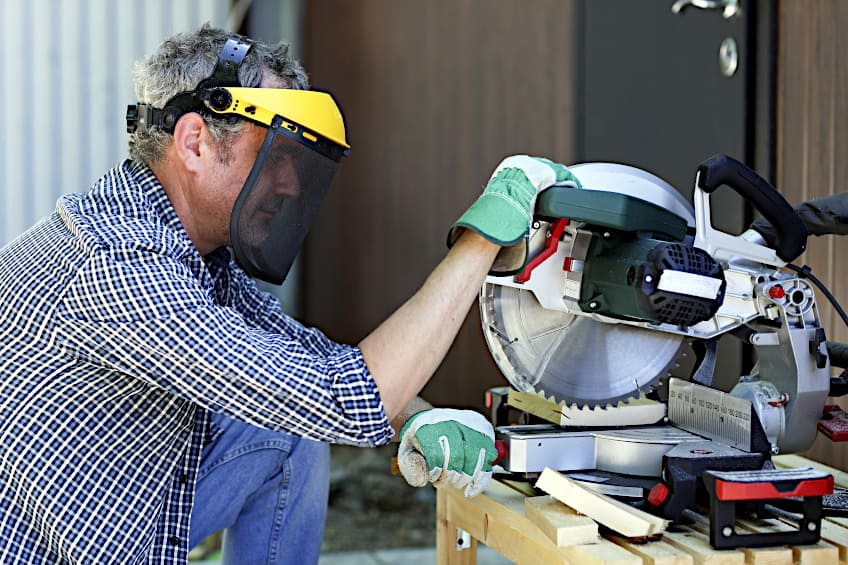
Now that you know what a chop saw and miter saw are, what the differences are between the two, what they are used for, how much they cost, and some of the key attributes associated with these machines, it’s time for you to get out there and put your newfound knowledge to the test. Always ensure that your guards are secure and that any power lines are unobstructed before operating these tools!
Frequently Asked Questions
What Is a Chop Saw?
While many people think they know when asked to define what a chop saw is, it can be quite challenging. What is a chop saw, then? Essentially, a chop saw is a powered circular saw attached to an arm that can be raised and plunged to cut specifically at a 90-degree angle only.
What Is a Chop Saw Used For?
While the name of a chop saw might seem to make its function pretty self-explanatory, it can be difficult to define. What is a chop saw used for, then? Chop saws are usually used to cut wood and metal using the combination of its 90-degree plunge and powerful motor.
What Is a Miter Saw?
A miter saw is essentially the same as a chop saw, with the only difference being the range of motion of the blade and the precision of its cuts. The blade can be manipulated at a 45-degree angle and moved horizontally in some instances.
What Is a Miter Saw Used For?
While the uses for a miter saw are vast, what is a miter saw used for exactly? Generally, miter saws are used to make precision cuts at multiple angles, primarily with wooden workpieces. These are usually used to make molds, cut trim pieces, and cut big pieces of wood board for use in rafters.

I have been into woodworking since 2005 and woodturning since 2011. Because of my love for wood and woodworking, I started woodhappen.com to teach other enthusiasts about how to finish and seal wood, the best woodworking tools, the different types of wood, and everything else related to woodworking! Read more about me here.

